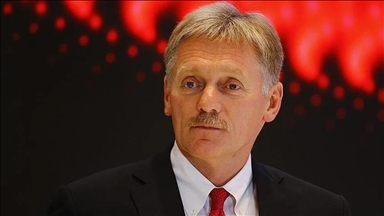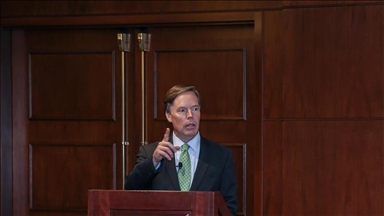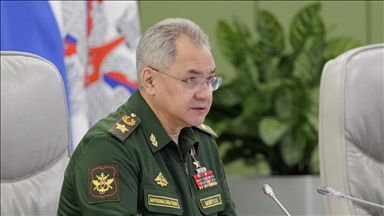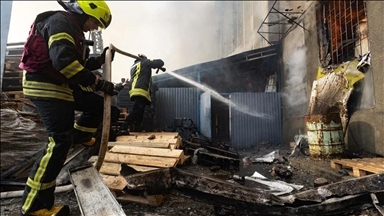Russian economy hit by most comprehensive sanctions of modern history in 2-year war period
Russian economy grows 3.6% in 2023 despite setbacks, outperforming Europe, US, as Russia finds new suppliers in Asia, Middle East
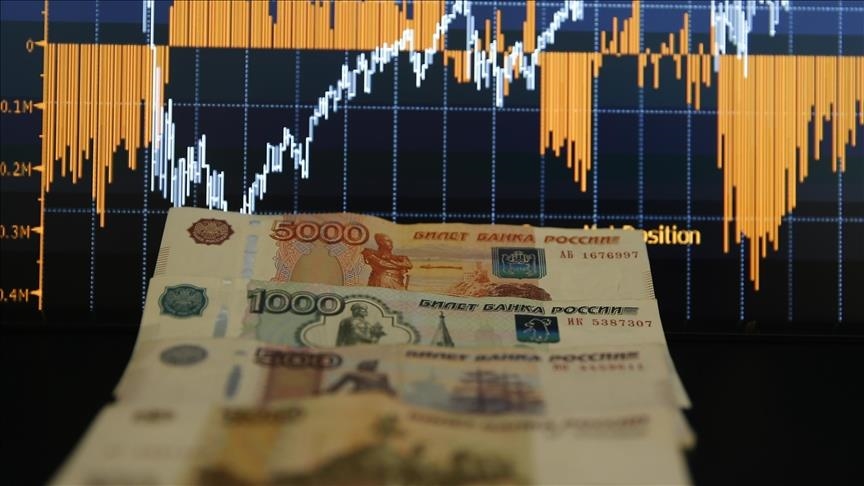
MOSCOW
Russia has been hit by the most comprehensive sanctions in modern history, as the Russia-Ukraine war completes its second year, along with an ongoing economic war with Western countries over their sanctions on Moscow.
Since the start of the Russia-Ukraine war in February 2022, Western countries have imposed many sanctions on the Russian economy and its international trade.
The sanctions targeted the energy, finance, defense industry, logistics, and aviation sectors, which all comprise the basis of the Russian economy, as well as the trade between Russia and Europe, which had grown rapidly after World War II.
More than $300 billion in assets belonging to the Central Bank of the Russian Federation and major Russian banks were frozen, and harsh restrictions were implemented on exports of key products, such as spare parts and technology.
The Russian economy was expected to collapse, according to officials and experts, but it outperformed Europe and the US in 2023, growing 3.6% despite setbacks.
Direct imports to Russia from Europe and the US fell significantly, although Russia found new suppliers mainly from Asia and the Middle East to fill in the gap in imports.
The country also discovered new markets, such as India, for oil and natural gas, making up the backbone of Russian exports.
Russia becomes world’s most sanctioned country
The total number of sanctions imposed by Western countries on individuals and entities in Russia since the beginning of the war in Ukraine reached 16,500 as of Feb. 12, according to data from Castellum.AI, the online sanction tracking platform.
The US imposed the most sanctions on Russia, with 3,500 sanctions, followed by Canada with 2,700, Switzerland 2,400, the EU with 1,700, and the UK with 1,700 sanctions.
The EU announced its 13th package of sanctions on Russia, and the US introduced 500 new sanctions against the country.
Many Western companies left the Russian market as well, suspending or significantly reducing operations in the country.
Major Western companies that have left the Russian market so far include the US-based iPhone maker Apple, Dutch aircraft maker Airbus, US-based aviation firm Boeing, global fast-food chain McDonald’s, US-based coffeehouse company Starbucks, Swedish furniture maker IKEA, UK-based oil firms BP and Shell, US-based oil firm ExxonMobil, automakers Mercedes-Benz, Nissan, and Renault, as well as US-based drink industry firm The Coca-Cola Company.
The effects of the impacts caused by sanctions were seen most in the automobile market, as the Chinese automobile brands Haval, Geely, and Chery replaced well-known brands of Toyota, Mercedes-Benz, Volkswagen, and Audi, which were the best-selling foreign car brands pre-conflict.
Russia saw the sale of 119,000 units of Chery brand vehicles, 112,000 of Haval, 94,000 of Geely, 48,000 of Changan, and 42,000 of Omoda in 2023.
SWIFT messaging network in Russia hit by sanctions
As Russia continues to adapt to new conditions set by many sanctions, the problems in the banking sector and international payments are among the most troublesome issues for the government.
Western countries decided to exclude Russian banks from the SWIFT messaging system, which is used to send and receive funds internationally, a sanction imposed on the country on the first days of the war.
Russia continues to experience various difficulties in the banking sector after two years full of sanctions, with restrictions imposed on the use of the euro and the dollar by the country’s central banks and other banks in Russia.
China’s leading banks recently imposed restrictions on payments with Russia due to concerns about secondary sanctions, as well as banks in India and the United Arab Emirates.
Russia developed the SPFS (System for Transfer of Financial Messages) as an alternative to SWIFT, and with its usage increasing, the authorities continue to search for more solutions to overcome the problems in the banking system, as SPFS has yet to be accepted internationally.
Although there have been various statements by Russian authorities for the use of cryptocurrencies in international payments, no official decision has been made, while the use of local currency in trade remains on the agenda.
Russia and China managed to increase the share of the Chinese yuan and Russian ruble in their trade, up to 90%, while a similar trend is observed in trade with India. But the potential threat of secondary sanctions does not help solve the problems in the banking sector.
Elvira Nabiullina, the governor of the country’s central bank, said on Feb. 16 that the bank is aware of the recent increase in problems with international payment, and it is holding consultations with all parties to find a solution.
Nabiullina noted that a concrete solution has yet to be found, as they believe digital financial assets, as well as an independent infrastructure for transmitting funds, are promising options for solving the problems in the banking sector.
‘De-dollarization’ process continues
The issue of trade in local currencies, which appears to be one of the most important ways to mitigate sanctions risks, is currently a hot topic on the Russian agenda.
The share of the Russian ruble in the country's trade with Europe increased from 43.6% to 49% compared to 2022, while it increased from 20.5% to 24% in trade with Asia, and from 21.9% to 48.1% in trade with Africa, according to data from the country’s central bank.
The share of the US dollar and euro in Russia’s total exports dropped from 86.9% to 26.7%, while the share of the Russian ruble rose from 12.2% to 36.1%, and the share of “friendly country” currencies increased from 0.9% to 37.2% in the same period.
The share of the US dollar in the country’s reserves was zeroed in 2021, and the share of British pound and Japanese yen were also zeroed in 2022, and the share of the euro by the end of 2023.
The assets of the Russian National Welfare Fund decreased by $17.7 billion last year to $133 billion, while only the Russian ruble, gold, and Chinese yuan-denominated assets remained in the fund.
As of Feb. 16, the total value of Russia's international reserves stood at $574 billion.
Asia emerges as new route for energy
As one of the world’s largest natural gas exporters, Russia had the biggest energy market after World War II, but the country lost its market share in Europe, significantly after the war in Ukraine.
As Russia’s share in important markets, such as Germany, Italy, and the UK, has been zeroed or significantly reduced, the country turned to the Asian market, especially to China and India, to continue its investments to compensate for the loss.
In 2023, 22.7 billion cubic meters of gas by Russia was shipped through the Power of Siberia pipeline, which is already shipping to China, and its capacity is expected to go up to 38 billion cubic meters in 2025.
Russia increases its investments in liquefied natural gas (LNG), which is more flexible in reaching export markets than pipeline gas, as the country’s planning process continues for the Power of Siberia-2 line.
The country produced 33 million tons of LNG in 2023, and it aims to expand the capacity to 110 million tons per year by 2030, said Alexander Novak, the deputy prime minister of Russia.
Meanwhile, the fact that the EU imported 17.8 billion cubic meters of LNG from Russia in 2023, up 31.9% compared to 2021, was of note.
Russia had a 2% share in India’s oil imports before the Ukraine war, but its share reached 30% in 2023, and hence becoming India’s largest oil supplier.
Whether the transformation process in the Russian energy sector will be successful in the medium and long term depends on several processes, such as the global economy, sanctions, and infrastructure investments, experts say.
As Russia needs time and investment to expand its pipeline and trade infrastructure to increase trade with Asia, a possible global economic slowdown could reduce overall demand for Russian exports.
The country’s oil exports fell 3.3% year-on-year in 2023, while natural gas exports through pipelines also went down 29.9%, according to data released by the Russian government on Feb. 6.
*Writing by Emir Yildirim in Istanbul
Anadolu Agency website contains only a portion of the news stories offered to subscribers in the AA News Broadcasting System (HAS), and in summarized form. Please contact us for subscription options.


